Contents
Mushroom farming is a fairly new and, indeed, profitable business. Most of the mushroom suppliers are small entrepreneurs who grow mushrooms in their basements, garages or premises specially built for this business. The most popular product is oyster mushroom. This mushroom grows quickly, does not require complex care, the technology for growing oyster mushrooms at home is very simple and will be clear even to a novice mushroom picker.
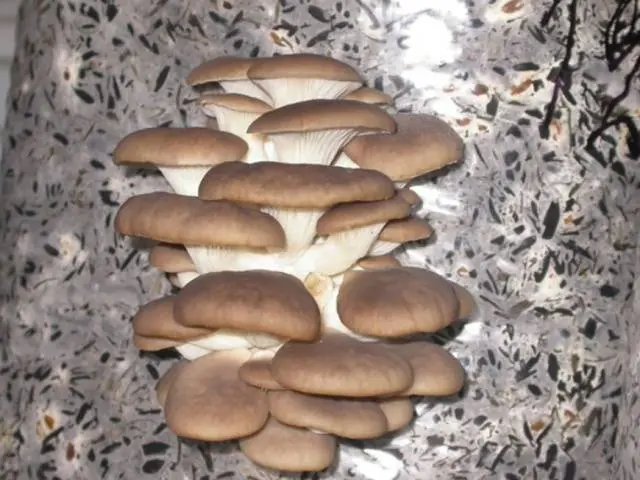
How to grow oyster mushrooms at home, how to understand the development of mycelium from scratch, without experience and special knowledge – this will be an article.
Features of oyster mushrooms
Unlike champignons, which need complex care, constant temperature adjustment, and daily moistening of the substrate, oyster mushrooms are less demanding. This is probably why more and more people are cultivating these mushrooms in their households.
Oyster mushrooms grow quickly – in six months you can harvest about four mushroom crops. Planting material for this culture is mycelium – germinated spores. To grow oyster mushrooms from mycelium, you need a special substrate, often these mushrooms are grown on tree stumps.
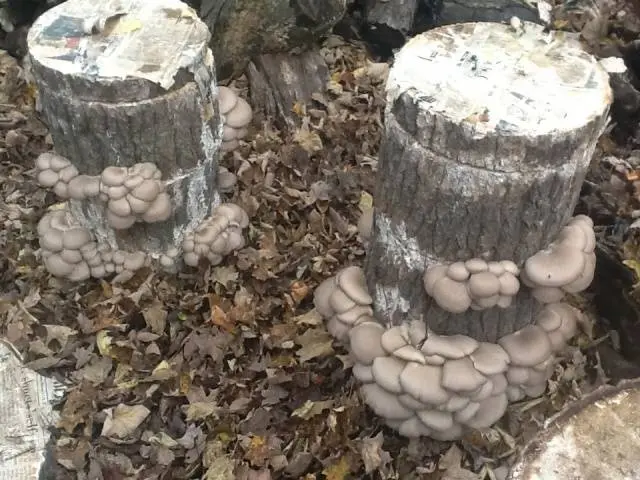
Also distinguish between extensive and intensive method of growing mushrooms. In the first case, oyster mushrooms grow in natural conditions, they do not create a special temperature or humidity for them, do not prepare soil mixtures – they simply lay mycelium in the ground and wait for the harvest.
The disadvantages of extensive cultivation are the dependence on weather conditions and the seasonality of this event – you can get a crop only in the warm season. As a result, this method can grow one or two batches of mushrooms per season. On the other hand, the economy of the extensive scheme is considered a big plus – no resources are spent on growing oyster mushrooms (for lighting, heating, humidification, etc.).

The intensive method involves the creation of artificial conditions for the growth of oyster mushrooms. Under comfortable conditions, mushrooms grow many times faster, they are practically not attacked by mold and insects, yields do not depend on external factors (weather, season, precipitation).
It is in an intensive way that oyster mushrooms are most often grown by beginners and experienced mushroom pickers in their households. If you follow the technology, you will not only be able to feed your family with hearty mushrooms, but also make a profitable business out of it.
How to grow oyster mushrooms at home using a substrate
Oyster mushrooms at home grow as well as in industrial ones. You just need to provide the mushrooms with everything you need, find the right room and take care of your mycelium every day.

How to grow oyster mushrooms at home step by step will be described below, in several paragraphs of the article.
Selection and preparation of premises for planting mushrooms
The most suitable place for growing oyster mushrooms at home is the basement or cellar. Here, the temperature is constantly positive, the humidity is quite high, and there are no drafts.
However, not every basement is suitable for oyster mushrooms, the room must meet several conditions:
- the cellar should be dry, in the sense that the floor or walls of the basement should not be heated or wet during the off-season.
- The temperature should always be about the same. To achieve this, it is enough to insulate the walls, floor and ceiling of the basement, and in winter use a small electric heater.
- Each square meter of the room should be illuminated by one 50-watt light bulb – this light is needed for oyster mushrooms to grow normally.
- Good ventilation is essential.
- The room must be protected from fungus flies and other insects, so all ventilation openings are covered with mosquito nets with a cell of up to 1 mm.
- There should not be any mold and fungus in the basement for oyster mushrooms – all this has a very detrimental effect on the crop, you can lose all the oyster mushrooms in a short time.
- Humidity should be maintained at 85-95%, while neither the floor, nor the walls or ceiling should be very wet so that the fungus does not develop.
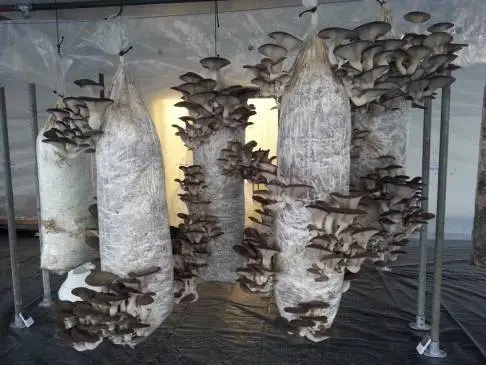
First of all, you need to prepare the room: remove the old racks, take out the vegetables and canned goods, disinfect and wash the basement. For disinfection, it is recommended to whitewash the walls with bleach or use smoke bombs. When mold is found, it is better to paint the walls with a special anti-fungal paint.
Substrate Preparation
To grow mushrooms, you need a special substrate. Any organic material that holds moisture well and allows air to pass through is suitable as a substrate. Most often used for oyster mushrooms:
- straw of wheat or barley;
- buckwheat husk;
- husk of sunflower;
- stalks of corn or other plants;
- corn cobs;
- sawdust or shavings of hardwood.
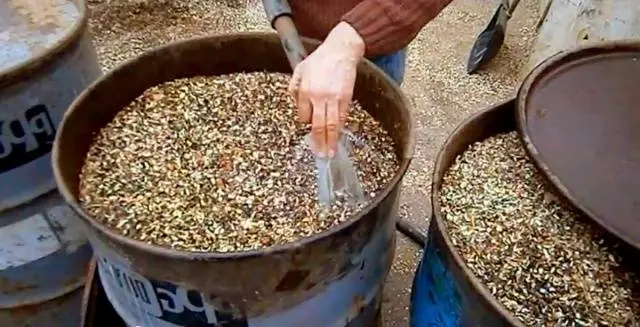
To grow oyster mushrooms, fractions of about 4 cm in size are needed, so the material for the substrate will need to be crushed. Be sure to check the substrate for traces of mold or fungus – such material is not suitable for mushrooms.
In order to prevent infection of the mycelium or mature oyster mushrooms with infections or fungus, the substrate must be heat treated. Processing may be different, but at home it is more convenient to use hot water treatment of the substrate. To do this, the substrate is placed in a container with water and boiled for 1-2 hours (depending on the size of the fractions).
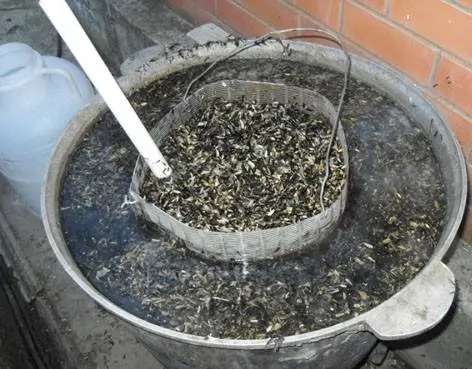
After boiling, the substrate should be squeezed out, for this you can put it under oppression or simply let the water drain naturally.
Bookmark mycelium
Oyster mushroom mycelium must be stored in the right conditions, if the temperature is disturbed, fungal spores will die. That’s why it is worth buying mycelium only from trusted manufacturers who follow the rules for storing and transporting such a product.
In order to grow four kilograms of oyster mushrooms, you will need about a kilogram of mycelium. It is most convenient to grow mushrooms in plastic bags, which must first be treated with a disinfectant.
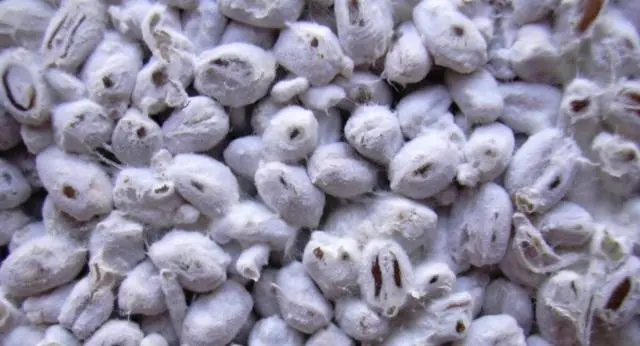
There are two options for preparing the substrate:
- Mycelium is mixed with the substrate
- Spread the substrate and mycelium in layers.
Regardless of the option chosen, you must first prepare the mycelium. Immediately after the purchase, the mycelium in bags is folded at home so that there is free space between the briquettes. The next day, the mycelium is taken to the basement, where the substrate is already located – the temperature of these components should even out.
Before opening the package, the mycelium is crushed by hand. Then they open the bag and take out the mycelium with gloved hands, mix it with the substrate for oyster mushrooms.

The amount of mycelium depends on the manufacturer: for domestic material, the proportion is 3% of the mass of the substrate, imported mycelium needs less – about 1,5-2%.
Filling bags
Plastic bags are also disinfected with alcohol or chlorine. After that, you can lay out a substrate with oyster mushroom mycelium in them. Beginners are advised to take small bags or bags that can hold about five kilograms of substrate. In large volumes, it is more difficult to control the temperature, because on the surface and inside the bag it can differ significantly.
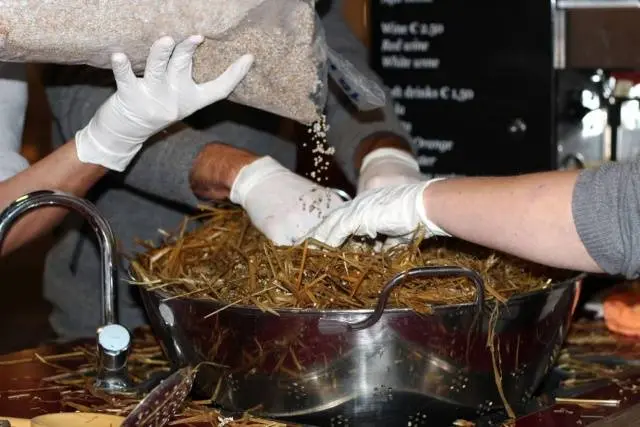
When the bags are filled with substrate, they are tied. On the one hand, each bag is pressed down a little, and holes are made in the opposite part. The holes are cut with a sterile and sharp knife, each about 5 cm long, they are made at an angle of 45 degrees.
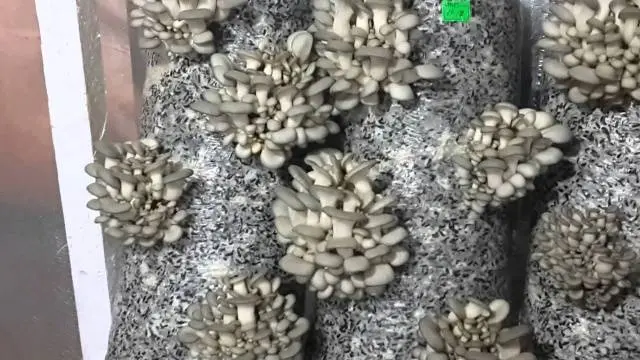
Ready bags are transferred to the room for incubation of oyster mushroom mycelium. The temperature in this room should be 25 degrees. Do not put bags close to each other, there should be a minimum gap of 5 cm between them.
Incubation and cultivation of oyster mushrooms
During incubation, the mycelium must grow through the substrate. This will become clear by the appearance of white threads penetrating the entire mass inside the bag.
In order for the mycelium to develop, a constant temperature is needed, fluctuations are unacceptable, they harm oyster mushrooms. Also during this period it is impossible to ventilate the basement. But you need to clean and disinfect the room every day using chlorine.
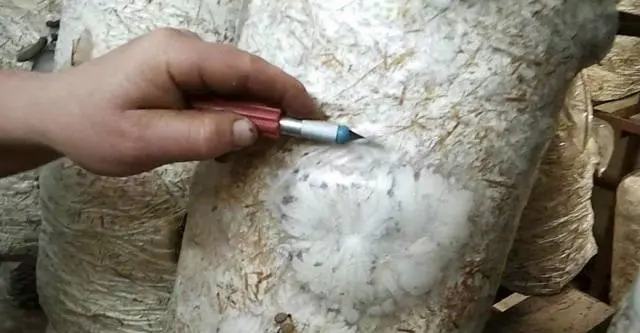
After 18-25 days, the mycelium will germinate, and bags with growing mushrooms must be transferred to another room for the next stage – cultivation. Here the temperature is lower – 10-20 degrees, and the humidity is higher – up to 95%. Even oyster mushrooms at this stage of development need light (at least 8-10 hours a day) and regular ventilation so that mold does not start.
Every day, the mycelium is moistened by spraying the appeared oyster mushrooms with water. You can also increase humidity by watering the walls and floor of the basement.

In a month and a half, you can wait for the first harvest of oyster mushrooms. Mushrooms need to be twisted with a leg, and not cut with a knife. After harvesting the first wave of harvest, in a couple of weeks there will be a second one – the same in terms of volume. There will be two more waves that will bring about 25% of the total crop.
How oyster mushrooms are bred on stumps
The usual cultivation of oyster mushrooms at home for beginners in the mushroom business may seem like a rather laborious and difficult task. You can recommend the following to beginner mushroom pickers: first, try growing mushrooms on stumps. This will allow you not to spend money on buying or preparing an expensive substrate, so in case of failure, the loss of a novice mushroom picker will be minimal.
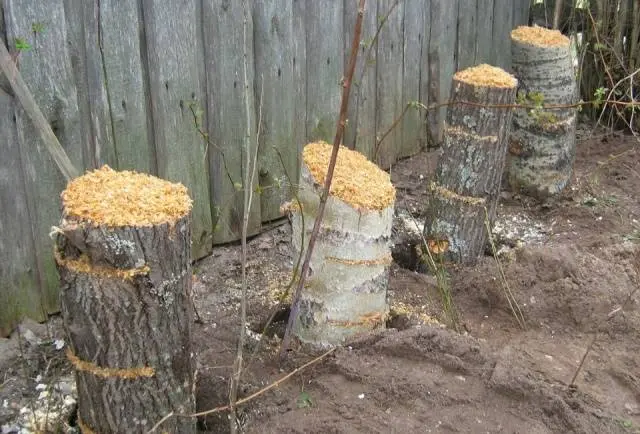
For oyster mushrooms, stumps or hardwood logs are needed. The optimal size of the stumps is 15 cm in diameter, about 40 cm long. It is better to take freshly cut logs, but in extreme cases, dry wood is also suitable. Dry wood should be soaked in water for a week before use.
The second necessary component is oyster mushroom mycelium. For growing on stumps, grain mycelium is most suitable – spores germinated on wheat grain.
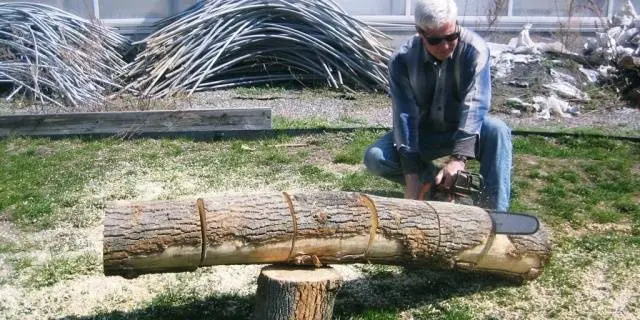
There are several ways to grow oyster mushrooms on stumps or logs, one of the most common involves the following steps:
- Holes should be dug in the ground, the width of which is equal to the diameter of the logs, and the depth is about 30 cm. The number of holes corresponds to the number of logs or stumps.
- The bottom of each hole is covered with thick paper (you can use parchment paper or cardboard).
- Mycelium is poured onto the paper, and wooden logs are placed on top.
- The resulting cracks must be tightly tamped with sawdust or dry foliage.
- Everything is covered with soil. That part of the logs that is above the ground can be covered with agrofibre (if the air temperature is low), and the distances between adjacent logs are covered with mulch.
- In order for the mycelium to germinate, sufficient moisture is necessary. Therefore, logs with oyster mushrooms need to be watered regularly. It is very convenient to use a drip irrigation system for these purposes.
- When the stumps turn white, it means that the mycelium has sprouted – the logs no longer need to be kept warm, the agrofiber can be removed.
- Ripe oyster mushrooms are cut with a knife, capturing whole bunches; it is not recommended to cut the mushrooms one by one.
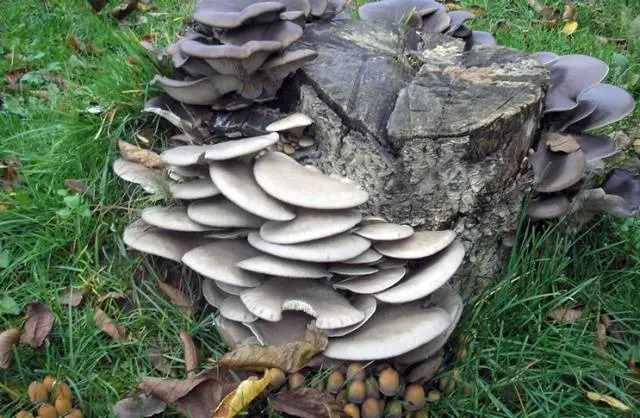
With this method of growing, you do not have to regularly buy mycelium – oyster mushrooms will grow until the logs are completely destroyed. Of course, for this you need to create all the conditions, then the mushrooms will not die, and will bear fruit for several seasons. For winter, wooden decks are removed to the basement or other cool room – the mycelium sprouted in stumps can live at temperatures down to -10 degrees.
The taste of oyster mushrooms grown in this way is no different – the mushrooms are just as tasty as those that grew in the substrate. Mushrooms on stumps are a great option for beginners or summer residents who rarely visit their site. This technology will not give a huge harvest, but it will be enough for a family of mushrooms.
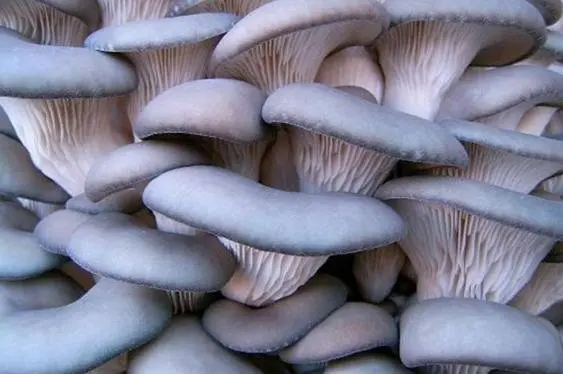
All this technology may seem complicated, and will scare off newcomers to the mushroom business. But a self-grown mushroom is probably more useful than a purchased one, because the owner knows on what substrate it was grown, by what means it was processed and other nuances. In addition, the mushroom business can become a good business and bring profit to the family.
The video will tell you more about how to properly grow an oyster mushroom crop at home:









